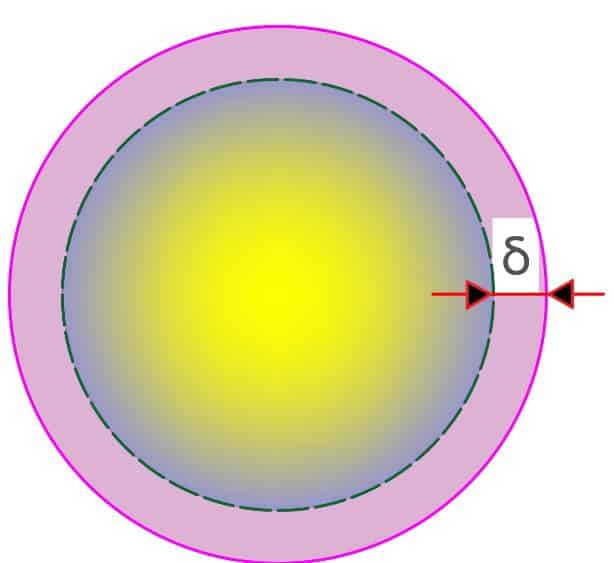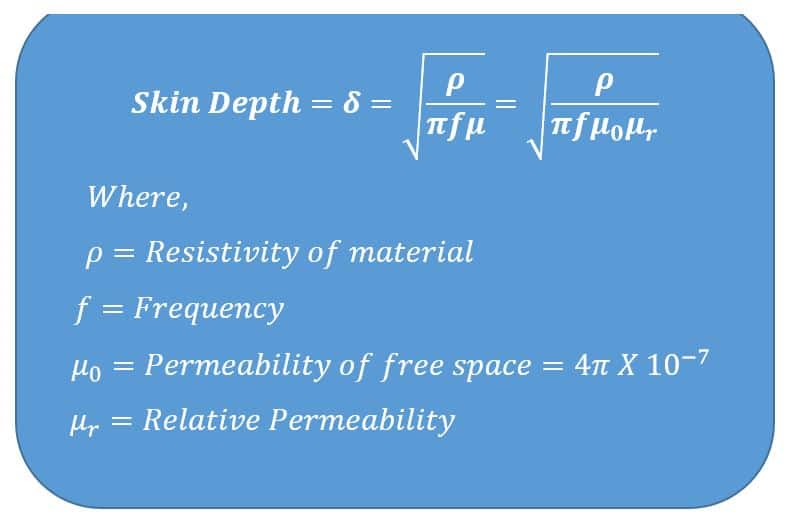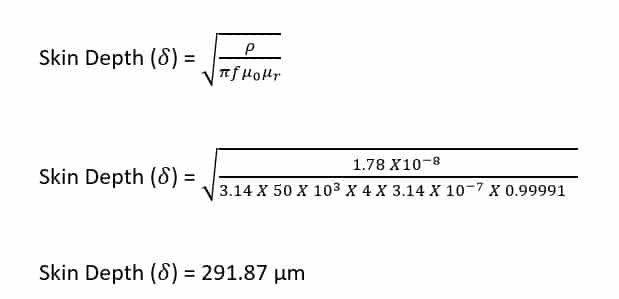Skin depth calculator is a tool used to find out the skin depth in the conductor. The depth of the conductor up to which current flows is known as the Skin Depth. The symbol of skin depth is δ.
It is commonly used to calculate the depth of current penetration in conductors for high-frequency AC applications.
What is the Skin Effect in Conductors?
An alternating electric current does not flow in the entire cross-section of a conductor. This happens because of Skin Effect.
In the case of AC, the current density is highest near the surface of the conductor and decreases exponentially as distance from the surface increases.
The skin effect phenomenon is absent in the case of DC because frequency of DC voltage or current is zero.

The AC resistance of the conductor depends on the supply frequency of voltage or current. The higher frequency current tends to flow on the surface of the conductor.
The reason is that there is more charge concentration near the surface of the conductor.
The charge concentration reduces from surface to the inner side of the conductor. It is maximum at the surface and zero at the center of conductor.
The skin depth (δ) is the distance from the conductor surface where the AC current denssity falls to 37 % of its maximum value. This occurs due to magnetic field interactions in AC system, which pushes current toward the conductor’s outer surface.
The skin depth changes with a change in frequency,relative permeability, and resistivity of conductor.
Skin Depth Formula and Equation
The formula shows how resistivity, permeability, and frequency affect the depth of AC current penetration in conductors like copper or aluminum.

The skin depth equation is derived from Maxwell’s laws and varies with signal frequency, permeability, and resistivity of the material.
Use Our Skin Depth Calculator Tool
Instead of solving complex equations manually, use our accurate skin depth calculator. Just input:
- Resistivity (µΩ-m)
- Frequency (kHz)
- (The calculator auto-applies permeability and constants as needed)
It instantly gives you the skin depth (δ) in micrometers for efficient AC resistance analysis and conductor design.
Skin Depth Calculator
Calculate the skin depth (δ) of a conductor based on its resistivity and frequency.
Enter values below to compute skin depth:
This helps engineers estimate AC resistance, understand current crowding effects, and optimize conductor size for high-frequency power transmission or RF applications.
Skin Depth of Copper and Aluminum at High Frequencies
As the frequency of alternating current increases, the skin depth decreases. This means current flows in a thinner layer near the conductor’s surface at higher frequencies.
The table below illustrates how skin depth reduces with increasing frequency for copper and aluminum conductors, expressed in micrometers (µm).
| Conductor | Frequency (kHz) | Skin Depth (µm) |
| Copper | 100 | 206 |
| Copper | 1000 | 65 |
| Copper | 10000 | 20.6 |
| Aluminum | 100 | 259 |
| Aluminum | 1000 | 81.9 |
| Aluminum | 10000 | 25.92 |
Solved Example: Skin Depth Calculation for Copper
Let’s look at a sample skin depth calculation using copper conductor data.
Calculate the skin depth for the copper conductor that carries 50 kHz.
Conductivity of copper conductor ρ = 1.78 X 10-6 Ω-m
Relative Permeability of copper μr = 0.999991
Skin depth formula for copper can be used to solve this using standard input values.

Practical Applications of Skin Depth in Electrical Engineering
Skin depth shows the region of the conductor that carries majority of current. The current flows up to the skin depth of the conductor.
If we use large diameter conductor and current flows up to 30 % of its depth, than the 70 % of depth does not carry current. Therefore, in this case it is not economic to use a large diameter conductor.
Thus, it is possible to economically design a conductor for a particular application by calculating the skin depth of the conductor.
For example, skin depth of the copper conductor for RF signal operating at 2.5 GHz is about 1.32 μm. Even, a large portion of a small wire size of about 30 AWG( 7.62 μm) remains unutilized , and the current flows up to the depth of 1.32 μm.
The concept is essential in RF signal transmission, where even small wire gauges can be inefficient if not properly selected. Engineers use skin depth values to reduce heating effects and increase energy efficiency in conductors.
Conclusion
Understanding skin depth is vital for optimizing conductor performance in high-frequency applications. It directly influences AC resistance, energy efficiency, and material cost in electrical systems.
Whether you’re working with RF coils, antenna design, or power transmission, calculating skin depth ensures that your conductor size matches the application’s frequency demands.
Use our Skin Depth Calculator to simplify the process and make data-driven decisions in your electrical engineering projects.
FAQs
The symbol of skin depth is δ (Greek letter delta). It represents the depth at which the current density in a conductor falls to 37% of its surface value due to the skin effect.
Skin effect is absent in DC because the current has zero frequency. Skin effect occurs only in AC systems where varying magnetic fields cause the current to shift toward the surface of the conductor.
Skin depth is inversely proportional to the square root of frequency. As frequency increases, skin depth decreases—meaning current flows in a thinner layer near the surface of the conductor. This increases the effective AC resistance of the conductor.
This effect is critical in RF coils, antenna design, and high-frequency transformers, where surface current dominates.
At 60 Hz, the skin depth of copper is approximately 8.57 mm. This value varies slightly with temperature and conductivity, but it’s a typical reference used in power system calculations.
Related Articles: